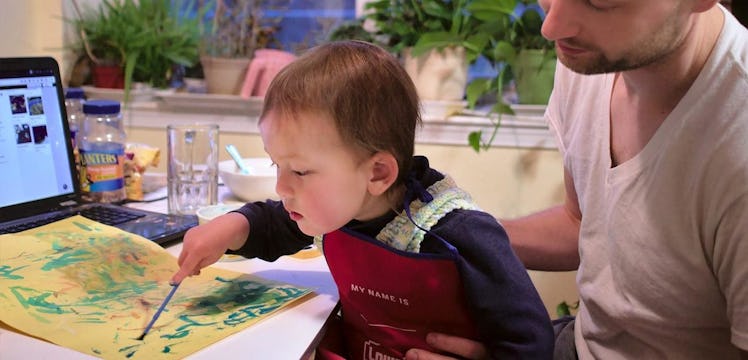How To Build A Schedule Your Toddler Will Love
Routine is key.

Everyone wants to know what’s going to happen in the future, including your kid. That explains the appeal of people like palm readers, clairvoyants, and Elon Musk.
But as a toddler, your kid really doesn’t have the patience to sit through a tarot card reading or a TED talk from a guy who just now discovered subways. So that means you have to be both their futurist and their Nostradamus. And the best way to do that is by building your kid a schedule.
Why Your Toddler Wants A Schedule
So the last thing a 1-ish year-old wants is to not have any clue WTH is coming at them next. It makes it incredibly tough to figure out where they stand in the world. Which sucks considering they’ve just learned to stand. Here are some reasons your kid might dig the routine:
They Love Repetition
What’s the proof for this? Reading number 1065 this week of Don’t Let The Pigeon Drive The Bus. And that’s not the only time your kid yells for Mo. That’s because repetition helps them learn stuff. And the more they learn, the more confident they feel in the world.
The same goes for repeating the same schedule every day. When your kid knows what’s coming up in their day they develop more confidence when it comes to navigating the world around them. Strangely, this obvious lack of control makes them feel like they have more control. Kids are weird
It Provides Comfort
It’s comforting to know that you’re going to get some outside time at 2 PM no matter what. And it’s doubly comforting to know that after outside time, you’re going to get to stuff your face with your favorite cookies.
A good schedule takes all the fear out of suddenly being exposed to new things. Because the fact is that newness is intimidating. Although you’ve probably forgotten that since you’ve seen it all, what with being a rugged world-weary dude.
It Helps When Things Do Change
With a tight and predictable schedule, it makes it easier to come back to level when things go sideways. That’s because your kid isn’t going to feel like a metaphorical left turn is going to be one in a series that will leave them lost.
That means if someone is called away unexpectedly, or the family goes on vacation, the schedule can still provide stability. That might just mean fewer meltdowns in your future.
How To Establish A Schedule
The best way to go about establishing a schedule is to look at the natural rhythms of your family as it stands. Then make sure you have some way to track the events of your day. Here’s what you’ll want to consider:
Time Blocks: When you start scheduling, it’s really up to you as to how deep you want to go with your time divisions. If you’re doing a stay-at-home dad thing, you could conceivably work an hourly schedule for your kid. But sometimes it helps just to get a morning schedule going. Or, better yet, an evening schedule that leads like a steadfast steed towards bedtime.
Visual Aides: A good schedule allows your kid to see what’s coming and what’s been done. There are dozens of ways to do this. They include flashcard systems, chalkboards, and apps. The important part is that you pair the type of chart with the way your kid works.
Flexibility: A schedule isn’t meant to take all of the spontaneity out of your life. In fact, it will probably help you build spontaneity into your life. It’s much easier to take a detour from the schedule when there is a schedule to come back to. And you can also build spontaneity into your schedule. Choose a block of time for some unstructured playtime and exploration.
With a good eye towards schedule design it’s very likely you’ll find you actually have a pretty calm and well-mannered toddler. In fact, they might just be the ones who remind you to look at the daily schedule. And while Elon may have the term on lock, you can’t deny that maybe you have the better powerwall.
This article was originally published on